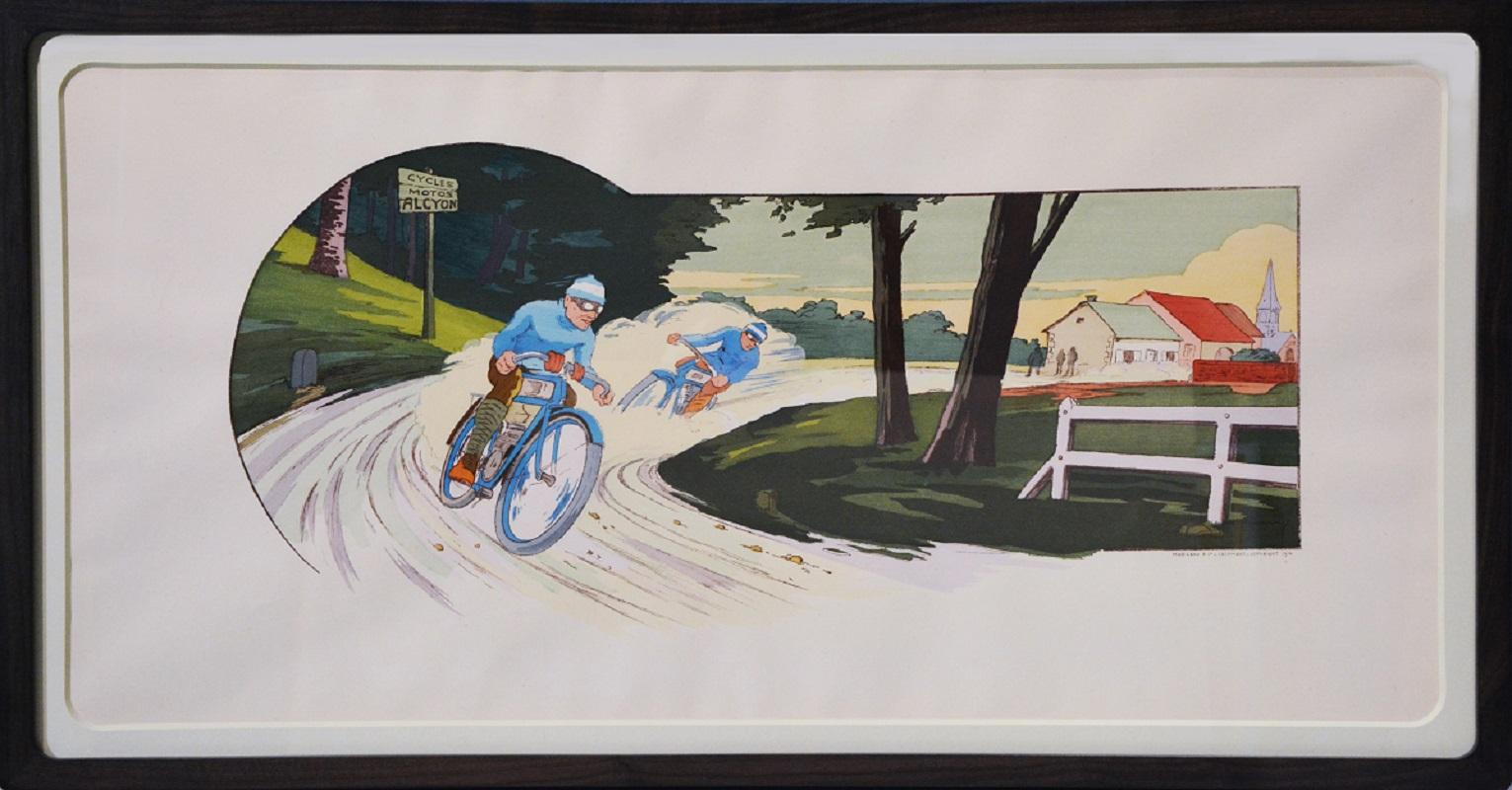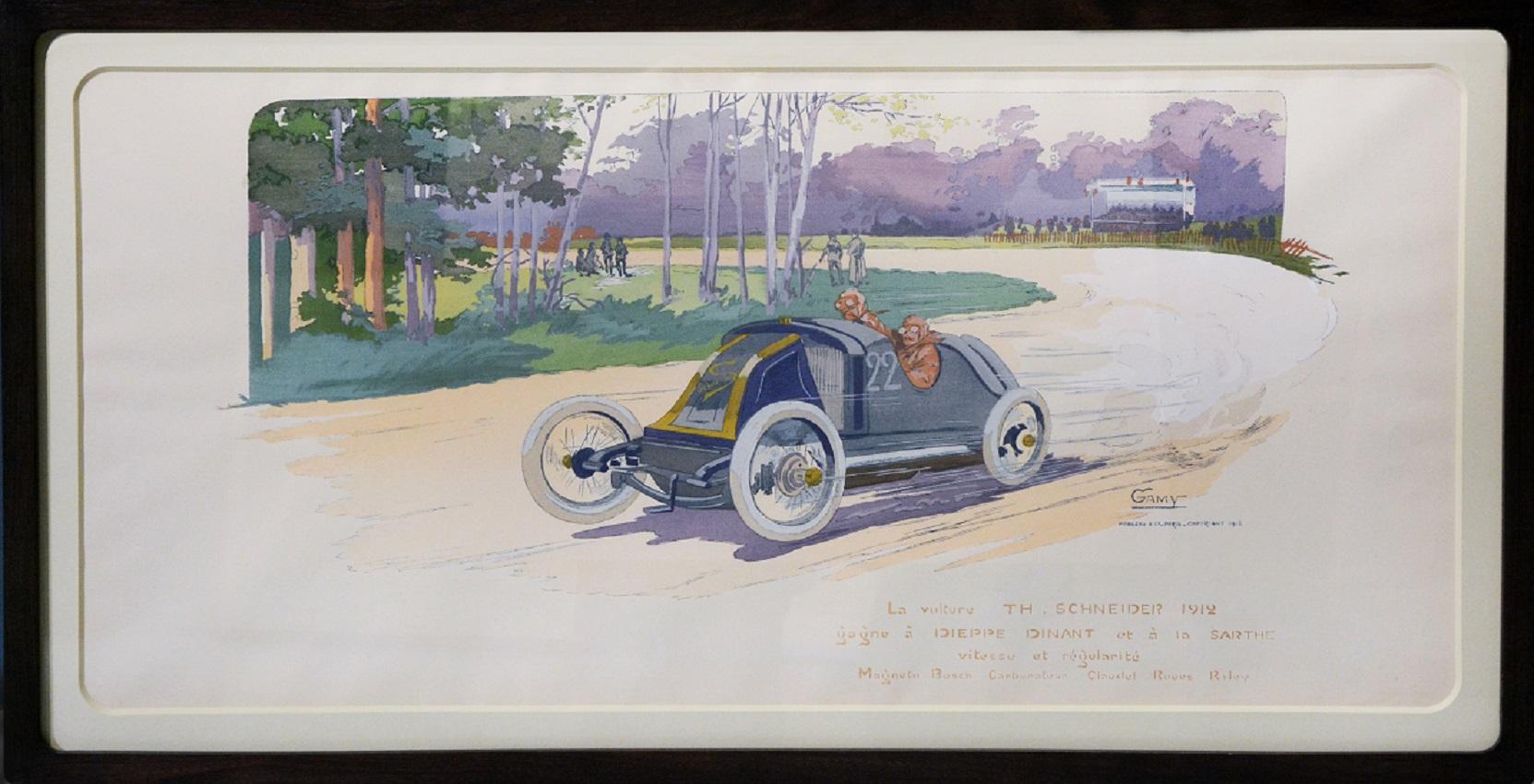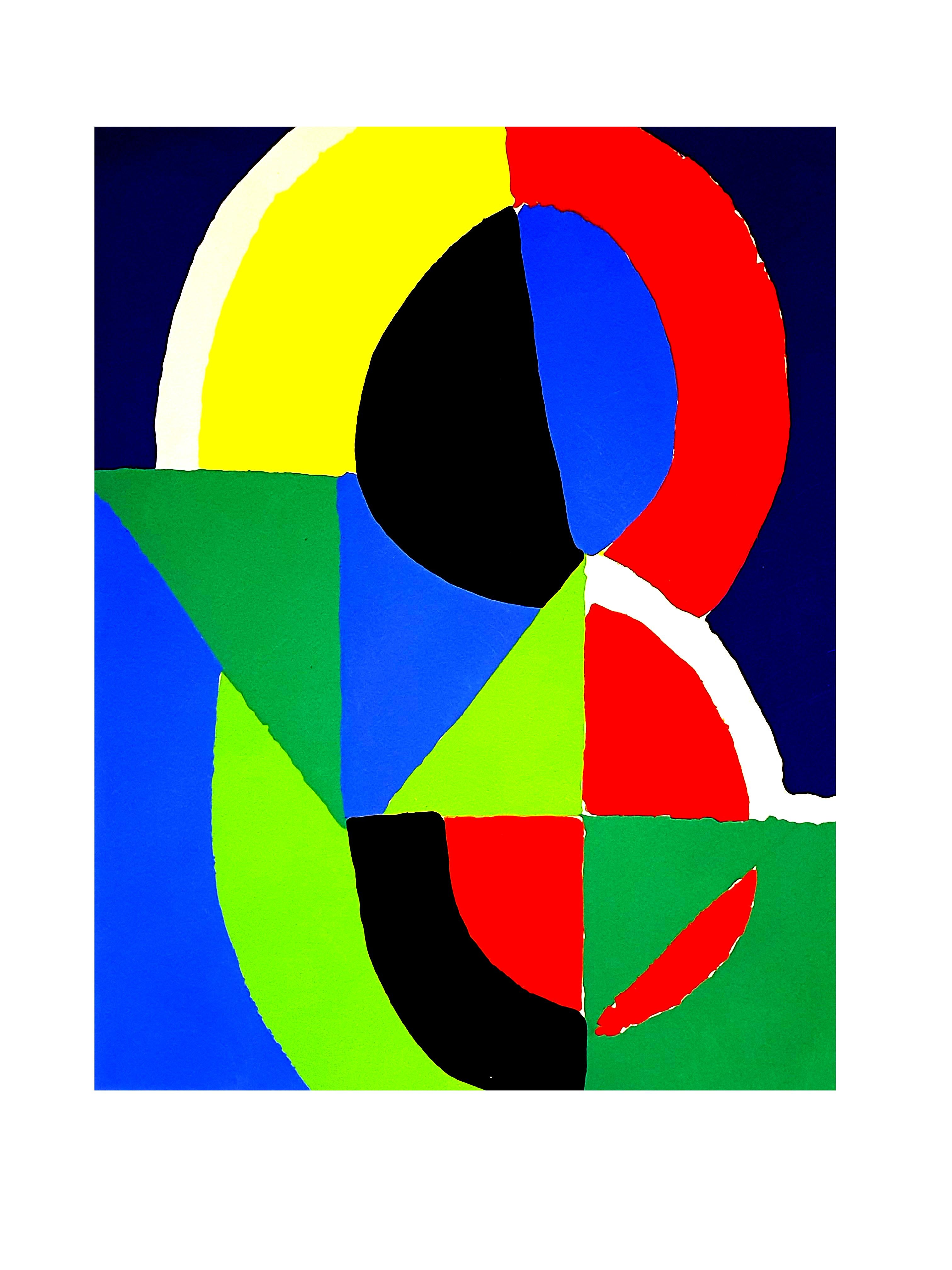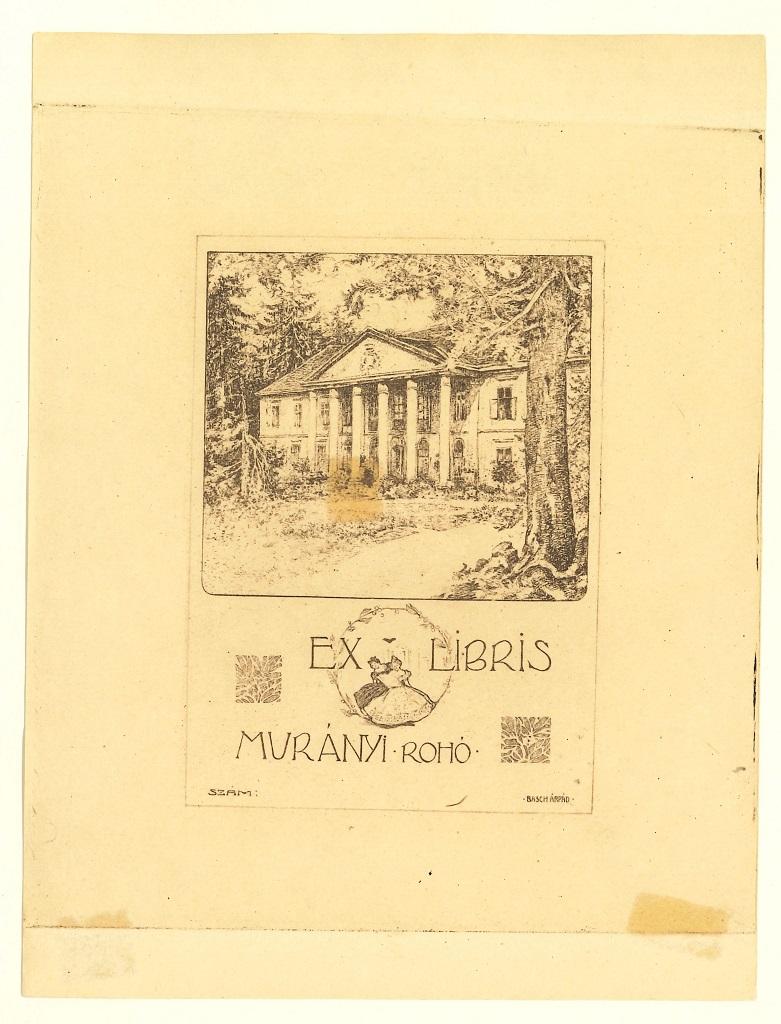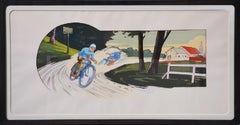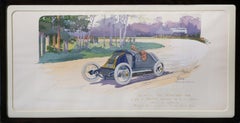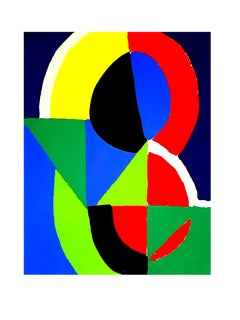Items Similar to Three Men Defending a Fort
Want more images or videos?
Request additional images or videos from the seller
1 of 10
Sadao WatanabeThree Men Defending a Fort1972
1972
About the Item
This artwork, "Three Men Defending a Fort" 1972 is an original color stencil on hand crumpled momigami paper. It is hand signed, dated and numbered 5/20 in black ink by the artist. The artwork size is 26.5 x 22.5 inches, framed size is 36 x 31.75 inches. It is custom framed in a wooden gold frame, with fabric matting and black color spacer. It is in excellent condition.
About the artist:
Sadao Watanabe born and raised in Tokyo, was a Japanese printmaker in the 20th Century. He was famous for his Biblical prints rendered in the mingei (folk art) tradition of Japan. As a student of the master textile dye artist Serizawa Keisuke (1895-1984), Watanabe was associated with the mingei (folk art) movement.
His father died when Watanabe was ten years old. He dropped out of school at an early age and became an apprentice in a dyer's shop. A Christian woman in his neighborhood invited the fatherless boy to attend church with her. At the age of seventeen, Watanabe received baptism.
The young Watababe worked in dyers' shops, sketching patterns and dyeing clothes. In 1937, one year after Yanagi Soetsu (1889-1961), father of the Japanese mingei (folk art) movement, had established the Folk Art Museum, the 24-year-old Watanabe saw an exhibition of Serizawa Keisuke's (1895-1984) work. The event sowed the seeds of Watanabe's artistic endeavor. A few years later, Watanabe attended a study group in which Serizawa taught his katazome technique of stencilling and dyeing, which originated in Okinawa. From then on, the teacher-and-student relationship between Serizawa and Watanabe became strong and abiding.
The subject matter of Watanabe's prints is exclusively the gospel rendered in the mingei (folk art) approach. Influenced by Buddhist figure prints, Watanabe placed Biblical subjects in a Japanese context. In The Last Supper (1981) Watanabe depicts the disciples in kimono. On the table are bottles of sake and sushi.
Watanabe uses kozo paper (from mulberry tree) and momigami (kneaded paper). The momigami paper was crumpled by hand, squeezed and wrinkled to give a rough quality to the prints. The katazome method uses traditional organic and mineral pigments in a medium of soybean milk. The protein in the milk bound the colors to the paper's surface. The use of natural materials is one of the characteristics of mingei (folk art).
In 1958, Watanabe received first prize at the Modern Japanese Print Exhibition held in New York City for The Bronze Serpent showing Moses and the people of Israel. Watanabe's Kiku [Listening] (1960) was featured in the novelist James Michener's The Modern Japanese Print (1962), a book that introduced ten sosaku hanga artists to the Western audience.
The Vatican Museum, the British Museum, the Museum of Modern Art in New York, the National Museum of Modern Art in Tokyo and many other leading museums in the world had exhibited Watanabe's works. During President Lyndon Johnson's administration, Watanabe's prints were hung in the White House.
Watanabe once remarked that he preferred that his prints hang in the ordinary places of life: "I would most like to see them [his prints] hanging where people ordinarily gather, because Jesus brought the gospel for the people". Such is the mingei philosophy of art for the people and by the people.
References
• Pyle, Anne H. H. (April 2000), "A Christian Faith in the Tradition of Japanese Folk Art: The Art of Watanabe Sadao (1913-1996)", Arts Magazine: 20-29.
• Watanabe, Sadao; Takenaka, Masao (1986), Biblical Prints, Tokyo: Shinkyo Shuppansha.
• Watanabe, Sadao (2000), Printing the Word: the Art of Watanabe Sadao, New York: American Bible Society.
• Heeding the Voice of Heaven, Sadao Watanabe, Biblical Stencil Prints, Brauer Museum of Art, 2010, Valparaiso.
- Creator:Sadao Watanabe (1913 - 1998, Japanese)
- Creation Year:1972
- Dimensions:Height: 36 in (91.44 cm)Width: 31.75 in (80.65 cm)Depth: 1.35 in (3.43 cm)
- Medium:
- Movement & Style:
- Period:
- Condition:
- Gallery Location:San Francisco, CA
- Reference Number:Seller: wat/thr/men/011stDibs: LU66635765371
Sadao Watanabe
Sadao Watanabe, born in Tokyo in 1913, used the medium called kappazuri ("stencil printing"), a technique related to 'katazome' ("stencil dyeing"). 'Katazome' is said to have originated in Okinawa (the method there was called 'bingata'). The paper most widely used in Japan for stencil printing is called 'shibugami', made from several layers of 'kozo' paper laminated with persimmon tannin. The sheets are dried and smoke-cured to strengthen them and make them flexible and waterproof. Once the artist makes a drawing, it is fixed to the 'shibugami' with a thin adhesive. The basic pattern is then carved into a "key impression" stencil (the equivalent to the keyblock in woodblock printing) called the 'omogata'. If colors will also be used for the final design, separate stencils are sometimes cut for each color. If the stencil pattern has thin lines they can be reinforced with silk gauze, which still allow for uniform printing of colors. The first stage of the printing process involves the application and drying of a dye-resist paste to cover all the portions of the design to be left unprinted by the design. The patterns and colors can then be brushed over the stencil while affecting only those areas without resist paste. Typically the first colors printed are the lighter areas so that darker colors can be overprinted. After all the colors are printed and dried, the key impression stencil is finally used to print the key design over all the previous colors. The dye resist paste is then washed off (called 'mizumoto', "to wash by water") and the paper is dried on a wood board. Watanabe typically printed on a colored ground, so he would first apply a color to the paper. Watanabe, who was baptized a Christian in 1930, based his designs exclusively on Biblical subjects, though his Christian stories and figures are interpreted through a filter of traditional Japanese techniques and even some older Buddhist figure prints. The folk-art movement in Japan began in the 1930s as an attempt to keep alive various traditional arts, among them stencil printing. Watanabe was an early member of a small but important group of artists who dedicated themselves to learning and preserving these arts. Watanabe's emotioonally moving Biblical prints are have been popular throughout the world, and have been hung in the Vatican, the White House, in museums and in private collections.
About the Seller
5.0
Platinum Seller
Premium sellers with a 4.7+ rating and 24-hour response times
Established in 1999
1stDibs seller since 2017
781 sales on 1stDibs
Typical response time: 2 hours
- ShippingRetrieving quote...Shipping from: San Francisco, CA
- Return Policy
Authenticity Guarantee
In the unlikely event there’s an issue with an item’s authenticity, contact us within 1 year for a full refund. DetailsMoney-Back Guarantee
If your item is not as described, is damaged in transit, or does not arrive, contact us within 7 days for a full refund. Details24-Hour Cancellation
You have a 24-hour grace period in which to reconsider your purchase, with no questions asked.Vetted Professional Sellers
Our world-class sellers must adhere to strict standards for service and quality, maintaining the integrity of our listings.Price-Match Guarantee
If you find that a seller listed the same item for a lower price elsewhere, we’ll match it.Trusted Global Delivery
Our best-in-class carrier network provides specialized shipping options worldwide, including custom delivery.More From This Seller
View AllMoses Smiting the Rock of Meribah, Exodus
By Sadao Watanabe
Located in San Francisco, CA
This artwork, "Moses Smiting the Rock of Meribah, Exodus" 1972 is an original color stencil on hand crumpled momigami paper. It is hand signed, dated and numbered 47/70 in White ink by the artist. The artwork size is 27.5 x 24.75 inches, framed size is 39 x 36 inches. It is custom framed in a wooden gold frame, with matting and black color spacer. It is in excellent condition, Please NOTE, the dark area at the lower left corner of the frame is only the shadow, the frame is in perfect condition.
About the artist:
Sadao Watanabe born and raised in Tokyo, was a Japanese printmaker in the 20th Century. He was famous for his Biblical prints rendered in the mingei (folk art) tradition of Japan. As a student of the master textile dye artist Serizawa Keisuke...
Category
Late 20th Century Modern Figurative Prints
Materials
Stencil
Price Upon Request
"Tu B'Shvat'" From the suite "The Seven Festivals"
By David Sharir
Located in San Francisco, CA
This artwork titled "Tu B'Shvat" from the suite "The Seven Festivals" 1981, is an original colors serigraph on Arches paper by noted Israeli artist David Sharir,b. 1938. It is hand s...
Category
Late 20th Century Modern Figurative Prints
Materials
Screen
"Rosh Hashana" From the suite "The Seven Festivals"
By David Sharir
Located in San Francisco, CA
This artwork titled "Rosh Hashana" from the suite "The Seven Festivals" 1981, is an original colors serigraph on Arches paper by noted Israeli artist David Sharir,b. 1938. It is hand...
Category
Late 20th Century Modern Figurative Prints
Materials
Screen
Happy Birthday Liberty, 100th Birthday of the Statue of Liberty. Large serigraph
By Hiro Yamagata
Located in San Francisco, CA
This artwork titled "Happy Birthday Liberty, 100th Birthday of the Statue of Liberty" 1986 is an original color serigraph on thick paper by renown artist Hiro Yamagata (Japanese, b. ...
Category
Late 20th Century Modern Figurative Prints
Materials
Screen
Flying Head
By Mihail Chemiakin
Located in San Francisco, CA
This artwork titled "Flying Head" c.1990, is an original colors lithograph by renown Russian artist Mihail Chemiakin, b.1943. It is hand signed and numbered 173/260 in pencil by the ...
Category
Late 20th Century Modern Figurative Prints
Materials
Lithograph
Acrobats
By Mihail Chemiakin
Located in San Francisco, CA
This artwork titled "Acrobats" c.1990, is an original colors lithograph by renown Russian artist Mihail Chemiakin, b.1943. It is hand signed and numbered 283/300 in pencil by the art...
Category
Late 20th Century Modern Figurative Prints
Materials
Lithograph
You May Also Like
Cycles Motos Alcyon.
Located in London, GB
GAMY and MONTAUT, Ernest.
Cycles Motos Alcyon.
[Paris: Mabileau & Co., c. 1914].
Hand-coloured pochoir print. Framed and glazed, overall size: 93.6cm x 49.2cm.
The Gamy-Montaut ...
Category
1910s Art Deco Figurative Prints
Materials
Screen, Stencil
La Voiture Th. Schneider, Car - 1912
Located in London, GB
GAMY and MONTAUT, Ernest.
La Voiture Th. Schneider, 1912 gagne à Dieppe Dinant et à la Sarthe vitesse et régularité / Magneto Bosch Corburateur Claudel Roues Riley.
Mabileau & Co., ...
Category
1910s Art Deco Figurative Prints
Materials
Screen, Stencil
Countdown To Violence, Spray Paint Stencil and Screen Print, Limited Edition
By Prefab77
Located in Palm Desert, CA
'Countdown To Violence' by Prefab77, 2012
Size 60 x 90 cm
Limited Edition of 10 (#4/10)
5 layer spraypaint stencils & 1 layer gloss black screenprint, on hand painted, hand-deckled F...
Category
2010s Street Art More Prints
Materials
Screen, Spray Paint, Stencil
(after) Sonia Delaunay - Composition - Pochoir
By Sonia Delaunay
Located in Collonge Bellerive, Geneve, CH
(after) Sonia Delaunay - Composition - Pochoir
1956
Dimensions: 32 x 25 cm
Revue XXe Siècle
Cahiers d'art published under the direction of G. di San Lazzaro.
Unsigned and unumbered ...
Category
1950s Abstract Geometric Figurative Prints
Materials
Stencil
Ex Libris Muranyi Roho - Original Woodcut Print - Early-20th Century
By Arpad Basch
Located in Roma, IT
Ex Libris Muranyi Roho is an original Artwork realized by the hungarian painter and engraver Arpad Barsch in the early-20th Century.
Signed by the artist on plate on the lower righ...
Category
Early 20th Century Modern More Prints
Materials
Woodcut
Lo Oscuro Invade
By Alexander Calder
Located in New York, NY
A very good impression of this color lithograph. It is initialed by Calder, signed by Carlos Franqui and numbered in pencil, from an edition of 500. Franqui was a Cuban author and po...
Category
1970s Modern Figurative Prints
Materials
Color, Lithograph
